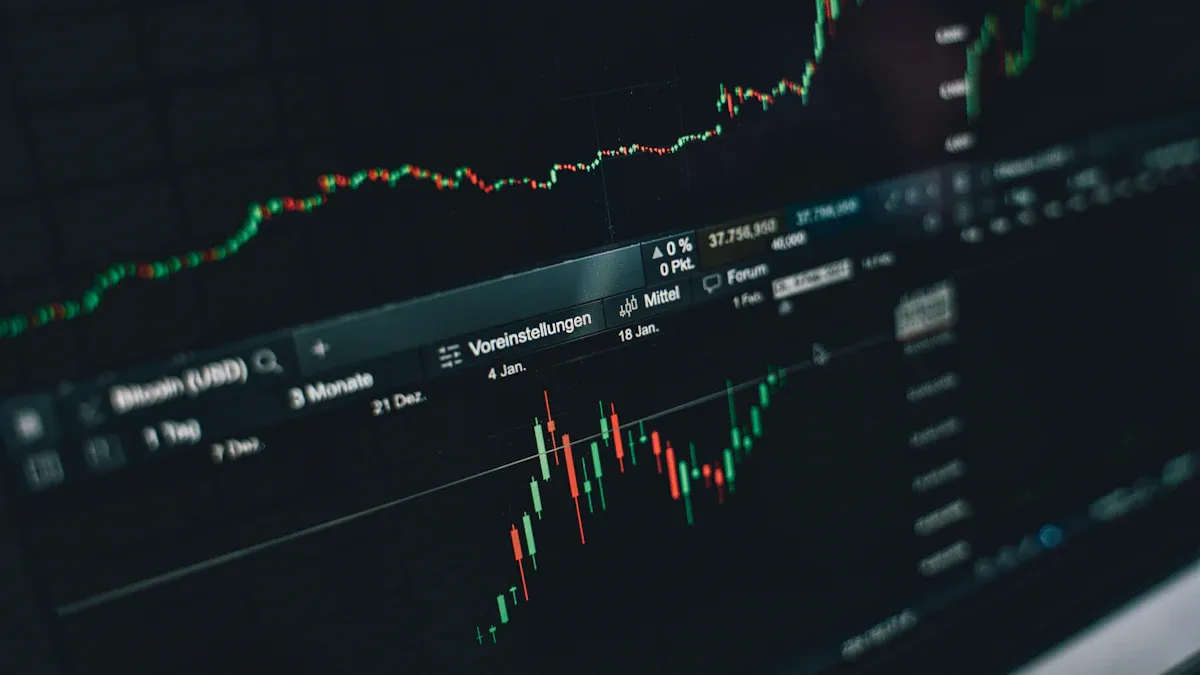- EasyCard
- Trade
- Help
- Announcement
- Academy
- SWIFT Code
- Iban Number
- Referral
- Customer Service
- Blog
- Creator
2025 Tencent Holdings Stock Price Trends and Financial Data Insights

Image Source: pexels
In 2025, the potential trajectory of Tencent’s stock price is garnering significant market attention. Based on available data, analysts’ average one-year target price reaches HKD 597.08, approximately 15% higher than the closing price of HKD 517.5 on May 12, 2025. This forecast reflects the company’s enhanced profitability, particularly with profit attributable to shareholders expected to rise by 18.3% to RMB 595 billion. Gross margin is also projected to improve from 52.6% to 53.7%, indicating the stability of its core businesses.
To deeply analyze Tencent’s future stock price trends, this article combines financial data, technical indicators, and industry dynamics to provide comprehensive insights. This multi-dimensional analysis approach helps predict market trends more accurately and offers investors more valuable recommendations.
Key Points
- According to analysis, Tencent’s stock price is expected to reach HKD 597.08 in 2025, showing stable growth potential.
- Investors should closely monitor policy changes and industry competition, as these factors may impact stock price performance.
- Combining financial data with technical analysis can help investors make more informed decisions, increasing investment success rates.
- Diversified investment is an effective strategy to reduce risk, and funds should be allocated across different industries and asset classes.
- Long-term investment in Tencent can yield stable returns, particularly given the growth potential of its core businesses, which deserves attention.
Tencent Stock Price Trend Forecast for 2025

Image Source: pexels
Historical Stock Price Trends and Volatility Range
Over the past few years, Tencent’s stock price has experienced multiple significant fluctuations. From 2018 to 2023, the stock price saw sharp ups and downs due to policy adjustments, industry competition, and changes in the global economic environment. For example, in 2021, due to tightened regulatory policies, the stock price once fell to around HKD 300. However, with the company’s business diversification and stable growth in core operations, the stock price gradually recovered to above HKD 500 in 2023. These historical data indicate that Tencent’s stock price volatility range typically falls between HKD 300 and HKD 600, with high sensitivity to external factors.
Key Factors Influencing Tencent’s Stock Price
Multiple internal and external factors collectively influence Tencent’s stock price performance:
- Policy Environment: Regulatory policies in China and Hong Kong have a profound impact on the technology sector, particularly changes in data privacy and anti-monopoly regulations.
- Market Demand: With the advancement of digital transformation, growing demand for cloud computing, gaming, and advertising businesses provides stable revenue for the company.
- Competitive Pressure: Market competition from other tech giants, such as Alibaba and ByteDance, may affect Tencent’s market share.
- Macroeconomic Factors: Global economic slowdown or changes in monetary policy may exert pressure on investor confidence and stock prices.
Potential Stock Price Trends and Market Expectations
Based on market analysis, Tencent’s stock price in 2025 may exhibit the following trend patterns:
- Using reflexivity theory to analyze market trends, investor behavior will continue to significantly influence market movements.
- Pay attention to market consensus, such as whether the company engages in share issuance or buybacks, as these actions may directly impact stock price volatility.
- Stock price strength tests and relative valuation methods can help investors more accurately understand potential trends.
The market generally expects Tencent’s stock price to maintain stable growth in 2025, primarily benefiting from improved profitability in its core businesses and expansion into emerging sectors. Investors should closely monitor policy changes and industry competition dynamics to better seize investment opportunities.
Financial Data Insights for Tencent Holdings
Analysis of Price-to-Earnings (P/E) and Price-to-Book (P/B) Ratios
The price-to-earnings (P/E) and price-to-book (P/B) ratios are critical indicators for evaluating stock valuation. Tencent Holdings’ P/E ratio reflects investors’ expectations for the company’s future profitability. According to the latest data, Tencent’s P/E ratio is approximately 25 times, indicating market confidence in its profit growth. In comparison, its P/B ratio is around 5 times, suggesting a premium of its stock price relative to its net assets per share.
The level of the P/E ratio is often influenced by industry characteristics. The high-growth nature of the technology sector typically results in higher P/E ratios compared to other industries. The P/B ratio, on the other hand, more directly reflects the value of the company’s assets. Tencent’s P/B ratio indicates strong asset quality and market optimism about its future growth potential. Investors should combine these two metrics to comprehensively assess the reasonableness of Tencent’s stock price.
Evaluation of Net Assets Per Share and Profitability
Net assets per share (Book Value Per Share) is an important indicator for measuring a company’s financial stability. Tencent Holdings’ net assets per share is approximately USD 15 (calculated using the latest exchange rate), demonstrating a solid asset base. This data is particularly important for long-term investors, as it reflects the company’s ability to withstand risks during challenging times.
In terms of profitability, Tencent’s earnings per share (EPS) continues to grow. In 2025, EPS is expected to reach USD 3.2, an increase of approximately 18% compared to the previous year. This growth is primarily driven by the stable performance of its core businesses and the expansion of emerging sectors. Improved profitability not only supports stable stock price growth but also delivers higher returns to shareholders.
Impact of Cash Flow and Debt Levels
Cash flow is a direct reflection of a company’s operational capabilities. Tencent Holdings’ free cash flow (FCF) has maintained steady growth over the past few years, with an expected FCF of USD 1 billion in 2025. Stable cash flow enables the company to pursue more business investments and shareholder returns, such as dividend distributions and stock buybacks.
Regarding debt levels, Tencent’s debt-to-capital ratio is approximately 35%, which is at the industry average. A moderate debt ratio indicates that the company maintains a balanced capital structure, leveraging debt to enhance returns while avoiding risks associated with excessive borrowing. Investors should closely monitor changes in cash flow and debt levels, as these factors directly impact the company’s future financial stability and stock price performance.
Technical Analysis: Tencent’s Stock Price Indicators and Tools

Image Source: pexels
Trend Signals of Moving Averages
The Moving Average is one of the most commonly used tools in technical analysis. It smooths out stock price fluctuations, helping investors identify long-term trends. Short-term moving averages (e.g., 10-day line) typically reflect recent market sentiment, while long-term moving averages (e.g., 200-day line) indicate more stable trends. When the short-term line crosses above the long-term line, it forms a “golden cross,” often considered a buy signal. Conversely, when the short-term line crosses below the long-term line, it forms a “death cross,” signaling a potential downward trend.
When analyzing Tencent’s stock price, investors should closely monitor the crossover points of moving averages and their relative positions to the stock price. These signals can help investors more accurately time their entry and exit points.
Candlestick Chart Patterns and Interpretation
Candlestick Charts provide the opening, closing, high, and low prices of a stock, presenting market sentiment graphically. Common candlestick patterns include “engulfing patterns,” “doji,” and “head-and-shoulders tops.” For example, when an engulfing pattern occurs, if a bullish candle fully covers the previous day’s bearish candle, it may signal a price rebound.
For Tencent’s stock price, analyzing candlestick patterns can reveal the balance of buying and selling forces and future trends. For instance, multiple “doji” patterns may indicate market indecision, requiring further confirmation from other indicators to determine the trend.
Application of RSI and MACD
The Relative Strength Index (RSI) and Moving Average Convergence Divergence (MACD) are two important technical indicators. RSI measures whether a stock is overbought or oversold, typically using 70 and 30 as key thresholds. When RSI exceeds 70, the stock may be overheated, signaling potential pullback risks; when below 30, it may present rebound opportunities. MACD provides buy and sell signals through the crossover of its fast and slow lines.
Below is the RSI and MACD data analysis for June 11, 2025:
| Buy | Sell | Neutral | Recommendation | Update Date |
|---|---|---|---|---|
| 21 | 2 | 31 | Strong Buy | 2025-06-11 |
From the data, it is evident that technical indicators for Tencent’s stock price show a strong buy signal, reflecting investor optimism about its future trends. The combined use of these tools can help investors more comprehensively evaluate market conditions.
Industry Dynamics and Risk Factors
Impact of Policy Changes on Tencent’s Stock Price
China’s regulatory policies have a profound impact on the technology sector, particularly changes in data privacy and anti-monopoly regulations. Over the past few years, regulatory authorities have intensified scrutiny of internet companies, imposing higher requirements on the business models of tech giants like Tencent. For example, policies aimed at preventing gaming addiction among minors directly affected Tencent’s gaming revenue. While these policy changes may exert short-term pressure on the stock price, in the long term, compliant operations will help boost market confidence.
Additionally, monetary policies in Hong Kong and China may influence investor preferences for technology stocks. If interest rates rise, increasing the cost of capital, it could suppress demand for high-valuation tech stocks. Therefore, investors need to closely monitor policy developments and adjust their investment strategies accordingly.
Analysis of Competitors’ Market Strategies
Tencent faces fierce competition from tech giants like Alibaba and ByteDance in the technology sector. Alibaba’s leading position in e-commerce and cloud computing poses challenges to Tencent’s advertising and cloud businesses. Meanwhile, ByteDance, with the success of Douyin and its international version TikTok, has rapidly captured market share in short-video platforms, pressuring Tencent’s social media operations.
However, Tencent’s investment strategy has secured its significant presence across multiple industries. In 2017, Tencent invested in 113 companies, surpassing the combined total of Alibaba and Baidu. These investments not only strengthened its market position but also provided a foundation for business diversification. Moving forward, Tencent needs to maintain stable growth in its core businesses while actively responding to competitors’ market strategies.
Demand and Growth Potential in the Technology Sector
With the acceleration of global digital transformation, demand in the technology sector continues to grow. Technological innovations in areas such as cloud computing, artificial intelligence, and data analytics offer Tencent vast development opportunities. In particular, the increase in mobile advertising spending highlights strong market demand for digital advertising. Tencent’s advertising revenue has maintained over 40% growth in the past five quarters, reflecting its significant influence in the market.
Additionally, the gaming business remains a key revenue source for Tencent. As the global gaming market expands, Tencent is poised to strengthen its market position by launching more high-quality gaming products. In the future, the growth potential of the technology sector will continue to support Tencent’s business development.
Investment Recommendations and Strategies
Strategies for Long-Term Investment and Short-Term Trading
When choosing between long-term investment and short-term trading, investors should make decisions based on their risk tolerance and financial goals. Long-term investment is suitable for those seeking stable returns, particularly for companies like Tencent with strong profitability and growth potential. By holding stocks for several years, investors can benefit from both dividends and capital appreciation. Moreover, long-term investment reduces the impact of short-term market volatility on portfolios.
Short-term trading is better suited for investors with market analysis skills and time management capabilities. This strategy requires close monitoring of market trends and technical indicators, such as moving averages and RSI. Short-term traders can capitalize on short-term price fluctuations for quick profits but must bear higher risks. Investors should choose strategies that align with their experience and resources.
How to Combine Financial Data and Technical Analysis for Decision-Making
Combining financial data with technical analysis can help investors make more informed decisions. Financial data provides detailed insights into a company’s fundamentals, such as profitability, cash flow, and debt levels, while technical analysis reveals market sentiment and price trends.
Below are best practices for integrating these two approaches:
- Integrate Data Sources: Avoid data silos by ensuring centralized management of all financial and market data.
- Enhance Data Quality: Ensure data accuracy and consistency to avoid decision-making biases caused by errors.
- Professional Skills Training: Investors should learn basic data analysis and technical analysis skills to improve decision-making capabilities.
- Establish Data Governance Systems: Develop clear data management processes to ensure data security and usability.
For example, a small e-commerce business analyzed customer purchase histories and browsing records, discovering that young customers preferred specific product styles. By adjusting inventory and marketing strategies, the business increased sales by 20%. This demonstrates that data analysis can directly add value to investment decisions.
Importance of Risk Management and Diversified Investment
Risk management is key to successful investing. Investors should set stop-loss and take-profit points to limit potential losses and lock in gains. Additionally, regularly reviewing portfolios ensures alignment with market changes.
Diversified investment effectively reduces the risk of single assets. Investors should allocate funds across different industries and asset classes, such as technology stocks, financial stocks, and fixed-income products. This way, even if one industry underperforms, the overall portfolio remains stable.
Pro Tip: Investors should avoid concentrating all funds in a single stock, even one as attractive as Tencent. Diversified investment enhances portfolio resilience, ensuring stable long-term returns.
In 2025, Tencent’s stock price forecast indicates stable growth potential, but market challenges warrant attention. Below are key observations:
- The stock price is relatively high, with a P/E ratio of 15–20 times, increasing the difficulty of short-term upward movement.
- Insufficient buying momentum in the market, with chip data suggesting limited stock price performance.
- Expected short-term volatility may intensify, requiring cautious observation of growth potential.
Combining financial data and technical analysis can help investors more accurately assess market opportunities. It is recommended to diversify investments and establish risk management strategies to address potential challenges and achieve stable returns.
FAQ
Is Tencent’s Stock Price Suitable for Long-Term Investment?
Tencent’s stable profitability and diversified businesses make it an ideal choice for long-term investment. Investors should consider its core business growth potential and industry position, combined with financial data for evaluation.
Can Technical Analysis Accurately Predict Stock Price Trends?
Technical analysis provides a reference for short-term market sentiment but cannot fully predict stock price trends. Investors should combine fundamental analysis with technical indicators to comprehensively judge market trends.
What Are Tencent’s Main Revenue Sources?
Tencent’s primary revenue comes from gaming, advertising, and cloud computing services. The stable growth of these business segments provides a strong profitability foundation for the company.
What Risks Should Investors Pay Attention to When Investing in Tencent?
Investors should focus on the impact of policy changes, industry competition, and macroeconomic factors on Tencent. Regulatory policies and fluctuations in market demand may pressure the stock price.
How to Effectively Manage Investment Risks?
Diversified investment is an effective way to reduce risk. Investors should allocate funds across different industries and asset classes, setting stop-loss and take-profit points to control potential losses.
With Tencent Holdings’ stock projected to reach HKD 597.08 in 2025, driven by an 18.3% profit growth and robust tech sector demand, policy changes and market volatility still pose investment risks—how can you capitalize on Tencent’s potential while diversifying globally? BiyaPay offers an all-in-one financial platform, enabling seamless trading of Hong Kong’s tech and financial sectors and US stable assets without offshore accounts, helping you mitigate market fluctuations and diversify risk.
Supporting USD, HKD, and 30+ fiat and digital currencies, real-time exchange rate tracking ensures cost transparency, while global remittances to 190+ countries feature transfer fees as low as 0.5%, significantly below traditional bank costs, with swift delivery to meet global wealth management needs. A 5.48% annualized yield savings product, with no lock-in period, balances stock volatility with steady returns. Sign up for BiyaPay today to integrate Tencent’s investment potential with BiyaPay’s worldwide financial solutions, creating an efficient, low-risk wealth management experience!
*This article is provided for general information purposes and does not constitute legal, tax or other professional advice from BiyaPay or its subsidiaries and its affiliates, and it is not intended as a substitute for obtaining advice from a financial advisor or any other professional.
We make no representations, warranties or warranties, express or implied, as to the accuracy, completeness or timeliness of the contents of this publication.




Contact Us
Company and Team
BiyaPay Products
Customer Services
is a broker-dealer registered with the U.S. Securities and Exchange Commission (SEC) (No.: 802-127417), member of the Financial Industry Regulatory Authority (FINRA) (CRD: 325027), member of the Securities Investor Protection Corporation (SIPC), and regulated by FINRA and SEC.
registered with the US Financial Crimes Enforcement Network (FinCEN), as a Money Services Business (MSB), registration number: 31000218637349, and regulated by FinCEN.
registered as Financial Service Provider (FSP number: FSP1007221) in New Zealand, and is a member of the Financial Dispute Resolution Scheme, a New Zealand independent dispute resolution service provider.




















